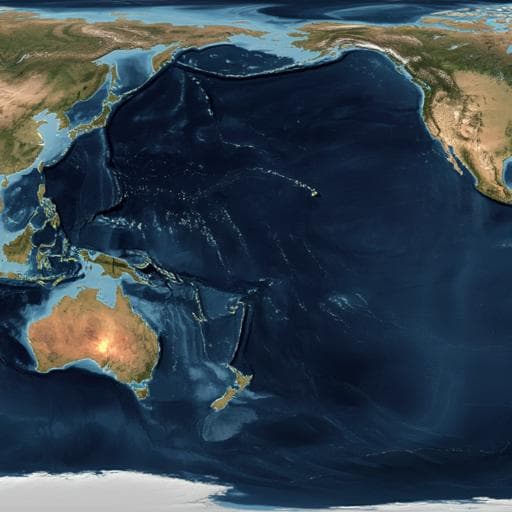
Earth Sciences
Forced changes in the Pacific Walker circulation over the past millennium
G. Falster, B. Konecky, et al.
Discover how a groundbreaking reconstruction of the Pacific Walker Circulation reveals unexpected historical patterns in climate response during 1200–2000. This novel research conducted by Georgina Falster, Bronwen Konecky, Sloan Coats, and Samantha Stevenson uncovers the intriguing influence of volcanic eruptions and potential anthropogenic effects.
~3 min • Beginner • English
Introduction
The Pacific Walker circulation (PWC) is a key component of tropical Pacific atmospheric circulation and is tightly coupled to ENSO, influencing global weather and climate. Despite its importance, how the PWC responds to external radiative forcings (greenhouse gases, aerosols, volcanic eruptions) remains uncertain, with conflicting evidence on whether anthropogenic forcing strengthens, weakens, or does not affect the PWC. Observations indicate a marked strengthening from ~1992–2011, but it is unclear whether this was forced or due to internal variability, especially as many climate models do not reproduce it. Short instrumental records and high intrinsic variability hinder detection of forced signals. This study aims to provide a long-term, annually resolved reconstruction of the PWC over 1200–2000 CE to contextualize recent changes, assess forced responses—particularly to volcanism and industrial-era anthropogenic forcing—and separate them from intrinsic variability by targeting trans-Pacific sea-level pressure gradients (ASLP).
Literature Review
Prior work and models frequently project a greenhouse-gas-driven weakening of the PWC via thermodynamic mechanisms, yet observations showed a late 20th-century to early 21st-century strengthening, sometimes attributed to aerosols or internal variability. ENSO reconstructions have been used to evaluate volcanic impacts, but tropical Pacific SST responses to eruptions are debated, and atmospheric circulation reconstructions are scarce due to methodological challenges. Existing preindustrial PWC inferences are generally decadally resolved hydroclimate composites, insufficient for interannual assessment. Studies have suggested aerosol-driven La Niña-like responses and model biases in recent SLP/SST changes. Earlier analyses often focused on SST-based ENSO proxies, which may under-detect atmospheric responses to forcing. This paper builds on these gaps by using globally distributed water-isotope proxies and multiple reconstruction methods to target ASLP directly.
Methodology
- Target variable: Anomalies in the trans-Pacific sea-level pressure gradient (ASLP), calculated relative to 1960–1990, where higher ASLP denotes a stronger, La Niña-like PWC and lower ASLP denotes a weaker, El Niño-like PWC.
- Proxy dataset: 59 annually or sub-annually resolved records (54 water-isotope records of precipitation and meteoric waters from the Iso2k database; 5 non-isotope records with strong mechanistic ties to PWC/ENSO). Records are globally distributed. Although not all directly reflect precipitation δ18O, it is the primary driver for most used records.
- Temporal nesting: Reconstructions performed in five temporal subsets (1200–2000, 1400–2000, 1600–2000, 1800–2000, 1860–2000) using records with >66% coverage in each interval to maximize data availability.
- Statistical approaches (ensemble-based):
• Composite plus scale (CPS), including variants: CPScoa (tropical Pacific centre of action only) and CPSns (records without known seasonal bias).
• Principal component regression (PCR) using all records (PCRall) and only those significantly correlated with ASLP in the calibration window (PCRcor, P<0.1).
• Pairwise comparison (PaiCo).
• Principal component analysis variants: opPCA (PCs computed over calibration interval and projected back) and fiPCA (PCs computed over full interval).
- Training data: Three gridded SLP products used to compute ASLP—HadSLP, ICOADS SLP, and ERA-20C—calibrated over 1900–2000.
- Uncertainty sampling and ensemble construction: Explicit chronological uncertainty incorporated by sampling many realizations from banded age–depth model ensembles for each proxy. In each ensemble iteration, up to 15% of records were randomly withheld to test sensitivity to data subsets. Methodological and observational uncertainties were captured by reconstructing with all method variants and all SLP products, yielding 4,800 ensemble members.
- Skill assessment and validation: A second reconstruction set with 1951–2000 calibration was used to evaluate independent performance over 1900–1950. Skill diagnostics and uncertainty partitioning were examined across time; skill decreases before ~1600 due to sparser coverage and greater chronological uncertainty.
- Spectral analysis: Power spectra evaluated for significant peaks (P<0.05) against power-law null across 1–75-year periods; comparisons made for preindustrial (1200–1849) vs industrial (1850–2000) intervals and in 150-year segments.
- Volcanic forcing analysis: Superposed Epoch Analysis (SEA) using eruptions with reconstructed stratospheric aerosol optical depth (SAOD) ≥ 0.05 (n up to 25). Significance determined with a double-bootstrap approach; sensitivity tested by restricting to more recent subsets (e.g., since 1862). Confidence intervals computed via random bootstrapping; responses summarized as proportions of ensemble members with significant positive/negative ASLP anomalies.
- Model comparisons: SEA applied to ASLP and Niño 3.4 SST in CESM1 Last Millennium Ensemble (13 fully forced members) and PMIP3/4 models (including an 8-member GISS-E2-R ensemble). Eruption strength thresholds varied (25, 12, 4 strongest) to test response robustness and scaling.
- Additional comparisons: Correlations between reconstructed ASLP and reconstructed GMST (PAGES 2k-based) across multiple periods and for ensembles; examination of industrial-era anticorrelation expectations.
Key Findings
- Reconstruction fidelity: The ensemble median ASLP closely tracks instrumental ASLP in the observational era, with high correlation to the mean of three SLP products (r=0.81) and strong independent validation (r=0.77).
- Variability characteristics: The PWC exhibits large interannual-to-decadal variability throughout 1200–2000. Significant spectral power is concentrated in 2–9-year periods (ENSO band), with about 10% of ensemble members showing significant decadal (~10–12-year) and multidecadal (~21–24-year) peaks. The industrial era (1850–2000) shows a shift toward higher power at lower frequencies (notably around 4–9 years, with particularly high power at 9 years) compared to 1200–1849.
- Industrial-era mean state: The distribution of ASLP values in 1850–2000 is slightly skewed to higher (more La Niña-like) values, but the difference in mean ASLP between preindustrial and industrial eras is not significant in 81% of the 4,800 ensemble members (P>0.05). There is no significant industrial-era (1850–2000) PWC trend, in contrast to most models that simulate weakening.
- 1992–2011 strengthening: The strong PWC strengthening over 1992–2011 is anomalous in the context of the last 800 years but not unprecedented; it is unlikely to be solely a response to the 1991 Pinatubo eruption, suggesting roles for anthropogenic aerosol forcing and/or internal variability.
- Volcanic forcing response: SEA reveals a significant El Niño-like PWC weakening (negative ASLP anomalies) in the 0–2 years following large eruptions, with rapid recovery by ~2–3 years. This result is robust across reconstruction methods and SLP products. The magnitude of ASLP response does not scale with eruption size. Inclusion of older eruptions weakens the composite signal, likely due to increased chronological uncertainty.
- Model support: In CESM1 LME, 9 of 13 members show a significant negative ASLP anomaly in the year after eruptions when considering the 25 strongest events; the fraction increases with higher eruption thresholds. The ASLP response is more consistent than the Niño 3.4 SST response. Across PMIP3/4, seven models (including three GISS-E2-R members) show significant ASLP responses vs five with significant Niño 3.4 SST responses.
- Relation to GMST: Correlations between reconstructed ASLP and reconstructed GMST are weak overall, with no robust anticorrelation in the industrial era; across 1200–2000, the distribution shows only weak anticorrelation. This implies any thermodynamic weakening of the PWC with warming may be masked by other forcings (e.g., aerosols), counteracting dynamics, or has not yet emerged above internal variability.
Discussion
The new annually resolved ASLP reconstruction provides a robust, long-term context for interpreting observed PWC changes. It shows that while the late 20th to early 21st-century strengthening is unusual, similar-scale variability has occurred historically, underscoring the large intrinsic variability of the PWC and complicating attribution. The absence of a significant industrial-era weakening contrasts with many climate model projections of thermodynamically induced PWC decline, suggesting that aerosol forcing, opposing dynamic responses, or insufficient anthropogenic CO2 forcing to date may obscure the expected signal. A clear, detectable El Niño-like atmospheric response to large volcanic eruptions emerges in the reconstruction and is more consistently reproduced in models for ASLP than for SST, indicating that atmospheric circulation indicators may be more sensitive—and therefore more reliable—diagnostics of volcanic forcing than SST-based metrics alone. The industrial-era shift to relatively lower-frequency variability hints at subtle anthropogenic influences, potentially linked to aerosol forcing patterns, even as a mean-state trend remains undetected. Together, these findings refine understanding of forced versus internal PWC variability and offer targets for improving model representation of tropical Pacific atmospheric responses.
Conclusion
This study presents the first annually resolved, multi-method, globally constrained reconstruction of the Pacific Walker circulation (via ASLP) over 1200–2000 CE that explicitly incorporates uncertainties from training data, reconstruction methods, proxy chronologies, and temporal data coverage. Key conclusions are: (1) no significant industrial-era PWC mean change despite model-predicted weakening; (2) an anomalous but not unprecedented 1992–2011 strengthening likely influenced by aerosols and/or internal variability; and (3) a robust El Niño-like weakening of the PWC following large volcanic eruptions, with an atmospheric ASLP signal clearer than corresponding SST responses in many cases. The reconstruction establishes an empirical baseline for future investigations into the dynamics of forced and intrinsic PWC variability. Future work should focus on diagnosing mechanisms of aerosol versus greenhouse gas influences, improving proxy-model comparisons (including treatment of chronology and non-stationarities), expanding high-resolution proxy coverage to enhance pre-1600 skill, and refining model physics to better capture atmospheric responses to external forcings.
Limitations
- Skill and data coverage degrade prior to ~1600 due to sparser proxy availability and greater chronological uncertainty, reducing confidence in early-period details.
- Chronological uncertainty increases back in time and can smear composite responses in SEA, particularly for older eruptions.
- Potential temporal non-stationarities in proxy–PWC relationships may affect reconstruction fidelity, especially during periods with multiple large eruptions.
- Inter-method differences arise from how statistical methods treat biases, leading to lower agreement around ~1800 and potentially influencing inferred low-frequency variability.
- Training relies on three gridded SLP products with their own uncertainties and biases.
- The study does not diagnose the detailed dynamics behind observed/forced responses, limiting mechanistic attribution.
- Industrial-era aerosol forcing patterns and magnitudes are uncertain, complicating separation of aerosol versus greenhouse gas effects.
Related Publications
Explore these studies to deepen your understanding of the subject.







